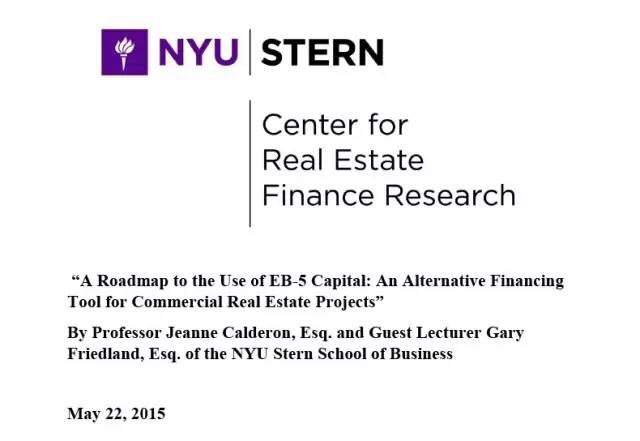【美国移民】纽约大学报告:EB-5融资与就业创造-EB-5进阶
今天继续NYU的报告。
纽约大学STERN商学院房地产金融研究中心的EB-5融资分析报告,该报告主要是以研究者的态度,向开发商和区域中心解释,传统房地产市场如何融资,开发商又应该怎样进行EB-5融资的,非常有技术含量。EB5Sir将其中关于房地产融资的关键部分,慢慢翻译给各位业内朋友参考。有需要该报告英文版的,也可以微信留言。

前几周发过两篇,一篇关于优先股和夹层贷款的介绍和区别,一篇关于过桥贷款的,今天发关于就业创造的,本文由业内朋友Dora义务翻译,特此感谢。
就业创造和EB-5资金募资规模
典型的EB-5项目都会涉及新建工程,因为这是满足就业创造要求的最常见方式。这个要求,与传统房地产项目能募集的资金规模相关,是对所能募集到最大额度的EB-5资金之主要约束。无论EB-5资金是债务还是股权的形式,这种限制都适用。
除EB-5投资之外,在确定商业地产抵押贷款(有时是夹层贷款)额度时, 进行抵押贷款的银行通常会考量的两个最重要的参数是:贷款价值比率(或在建筑贷款情况下是,贷款成本比率),以及,偿债保障比率。
然而,在EB-5项目中,开发商和区域中心还需要专注于商业计划书,表明EB-5项目所需的必要的最低就业人数将被创造出来。大多数开发商努力创造出比最低需要更多的就业机会从而形成就业缓冲。
再次,对于每位EB-5投资人,项目必须创造10个新的就业机会。假设该项目坐落在目标就业区(TEA)内,每募集500,000美元的EB-5资金,就必须创造10个就业。例如,如果一个项目预计将创造100个新的就业机会,那么项目能募集的EB-5资金的最大金额是500万美元。
反过来说,如果EB-5筹资目标是500万美元,那么所需的最低就业数量是100个。
EB-5项目的所有新增就业岗位,包括使用公共资源提供的基金所创造的就业岗位,不管其投入资金的来源或数量,都可以分配给EB-5投资者,即使EB-5投资只是占据项目总成本的一个非常小的比例。
基于商业计划和经济模型的,项目预计将创造的就业总数(包括就业缓冲),必须超出合格的EB-5投资者所需就业岗位的最低数量。项目预计创造的就业总数除以所需就业的最低数量可以被认为是EB-5项目的“就业覆盖率”。如果项目缺乏就业缓冲(也就是说,预计创造的就业数量等于EB-5的最低要求),就业覆盖率就是1.0。在上面涉及募集500万美元EB-5资金的例子中,如果项目预计将创造150个就业岗位(比所需最低要求100个多50个),那么实际就业覆盖率是150/100或1.5,表示有50%的就业缓冲。
就业覆盖率反映了EB-5法规对于创造就业的要求。相对应的,贷款价值比率和偿债保障比率是贷款方评判是否借款的标准,不同的贷款方和不同的项目类型会有不同的要求。当然,无论项目是否含有EB-5资金,高级贷款银行都会利用标准的典型承销标准来评估是否贷款。
以下是另一种更简单的方法。首先,确定能够募集的EB-5资金总量,除以百万,乘以 2得到所需投资者的数量(即,2为每1,000,000美元投资所需500,000美元的投资者的数量)。然后,乘以10得到项目为支撑这些资金所需的最低创造就业数量。将项目预计会创造的就业总数与所需的最低数量对比。如果总就业数更大,就业缓冲数等于多余的就业数。就业覆盖率是所创造的就业总数除以所需的最低就业数。
尽管美国移民局(USCIS)对具体项目并不考虑是否存在就业缓冲,但是最近USCIS在一个范本认证申请的批复函,可以帮助说明如何确定就业缓冲。USCIS的批复函是关于Lightstone区域中心的第一个项目,新商业企业(NCE)为2.08915亿美元总成本的项目,借款5,000万美元的EB-5资金。基于Lightstone递交的商业计划书和经济分析报告,USCIS认为该项目可能产生1,423个就业岗位。然而,募集5000万美元仅需要创造1000个新的就业机会(5000万美元/ 50万美元每位投资者)。因此,存在423个就业缓冲岗位。预计就业覆盖率为1.423(项目总创造的1423个就业 / 1000个最低就业要求)。此外,上面的Lightstone例子,即使5,000万美元只占了不到25%的项目总成本,所有项目资金来源创造的1,423个就业岗位都可以分配给EB-5投资者,而不仅仅是按照EB-5资本比例份额来进行分配。
虽然建筑工程所创造的就业是基于合格的建筑工程花费,但是并非所有建筑工程花费都能被USCIS确定为创造就业的合格花费。例如,USCIS不认可某些土地收购成本、应急预算或利息、开发费用和其他建设软成本等之类的费用,作为“创造就业的花费”。虽然,EB-5投资资金可以用来收购土地和支付这些不被认可的软成本。但是这些资金花费必须被排除在经济-就业影响研究报告之外,因为USCIS不允许EB-5项目计算这些花费创造的就业。
本文来源:纽约大学STERN商学院房地产金融研究中心的EB-5融资分析报告。
Job Creation and Size of EB-5 Capital Raises
The typical EB-5 project involves new construction because this is the most common way to satisfy the job creation requirement. This requirement, while irrelevant to the size of capital raises for conventional real estate projects, poses the primary constraint on the maximum size of an EB-5 capital raise. This limitation applies whether the EB-5 capital takes the form of debt or equity.
Outside of the EB-5 arena, in sizing a commercial real estate mortgage loan (and sometimes mezzanine debt), two of the most common metrics a lender typically considers in underwriting a mortgage loan are the loan to value ratio (or loan to cost, in the case of construction loans), and the debt service coverage ratio.
However, in EB-5 projects, developers and Regional Centers also focus on developing a business plan that, at a minimum, demonstrates that the requisite number of jobs will be created to satisfy the EB-5 program requirements. Most developers strive to build in a job cushion to create more jobs than the minimum required.
Again, for each EB-5 investor, the project must create 10 new jobs. Assuming that the project is located within a TEA, 10 jobs must be created for every $500,000 of EB-5 capital raised. For example, if a project is expected to create 100 new jobs, then the maximum amountof EB-5 capital that can be raised for that project is $5 million.
Conversely, if the targeted EB-5 capital raise is $5 million, then the minimum number of jobs required is 100.
All of the new jobs created by an EB-5 project, regardless of the source or amount of invested capital, can be allocated for EB-5 purposes to the EB-5 investors, even if EB-5 capital represents a very small percentage of the total project costs.217 This includes jobs created with the use of fund provided by public sources.
The total number of jobs expected to be generated by the project (including the job cushion), based on the business plan and economic model, must be compared with the minimum number of jobs necessary for all of the EB-5 investors to qualify. The total number of jobs divided by the minimum number of required jobs can be considered the “job coverage ratio” for EB-5 projects.218 If the project lacks a job cushion (that is, the number of jobs projected is equal to the EB-5 minimum requirement), the job coverage ratio would be 1.0.219 In the above example involving a $5 million EB-5 capital raise, if the project is expected to create 150 jobs (50 more than the 100 minimum required), then the actual job coverage ratio would be 150/100 or 1.5, representing a cushion of 50%.
The job coverage ratio reflects the job-creation requirement imposed by the EB-5 law. In contrast, the loan to value and debt service coverage ratios are underwriting criteria imposed by lenders that vary by lender and by project type. Of course, the senior lender also utilizes standard typical underwriting criteria in evaluating whether to make the loan, whether or not an EB-5 capital component is included.
An alternative, simpler way to view this follows. First, take the total dollar volume of EB-5 capital sought to be raised, multiply the number of millions x 2 to arrive at the number of investors (that is, 2 investors at $500,000 each for each $1,000,000 of investment). Then multiply that by 10 to arrive at the minimum number of jobs required to support the capital. Compare the total jobs estimated to be created by the project and compare that to the minimum number required. If the total number of jobs is greater, the job cushion equals the excess jobs. The job cushion ratio would be the total number of jobs divided by the minimum number.
Although the USCIS does not consider whether a job cushion exists for a particular project, a recent USCIS determination letter in response to an exemplar filing helps illustrate how the job cushion would be determined. The USCIS determination letter regarding the initial project by the Lightstone Regional Center states that the NCE will loan $50 million of EB-5 capital towards the total project cost of $208.915 million. Based on the business plan and economic analysis submitted by Lightstone, USCIS determined that the project is likely to generate 1,423 jobs. However, the $50 million raise would require the creation of only 1,000 new jobs ($50 million/$500 thousand per investor). Thus, a job cushion of 423 jobs exists. The job coverage ratio is 1.423 (1,423 total projected/1,000 minimum jobs required). Furthermore, in the Lightstone example above, even though $50 million represents less than 25% of the total project costs, all 1,423 jobs for all project capital sources can be allocated to the EB-5 investors, rather than merely the proportionate share represented by the EB-5 capital.
微信回复“目录”可查询主要文章目录,或者点击左下角“阅读原文”的链接,进入www.eb5sir.com查阅往期文章。EB5Sir,在区域中心和律所工作多年,如有任何问题意见建议,可进入公众号留言,也欢迎在文章右下角的写评论,互动讨论。
